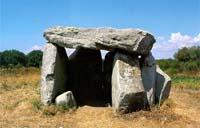- Home
- Discover the megaliths of Morbihan
- Monumentalism
- Milestones
- What are megalithic monuments?
Kerveresse in Locmariaquer: the typical image of the megalithic tomb reduced to the frame of his room.
"They are large stones" (G. Flaubert)
The growing awareness of these strange monuments coincides with the emergence of prehistory in general. The word "megalithic" was first used in 1839 by the Reverend HERBERT, an English scholar.
Kerveresse at Locmariaquer is a typical megalithic tomb of which nothing is left but the structure of its chamber
In France, the word started to be commonly used around 1860 (its use was ratified by the 1867 International Anthropology Congress, in Paris).
The word "megalithic" comes from the Greek words Mega (large) and Lithos (stone). The adjective "megalithic" refers to structures made out of roughly assembled stone blocks. The word gives no indication of age or function (at the time, these questions were controversial issues).
Research provided the answer to both those questions. It also showed that megalithic structures were nothing but the frame on which much more complex monuments were built, using more sophisticated building techniques and materials such as drystone masonry, earth and wood.
Remains of other monuments were identified at the same time: they obviously belonged to the megalith "family" although they were no longer built with "large stones". Such monuments were found even in those areas which had no identifiable "real megaliths".
Rather than resort to another word, the word "megalithic" was used for both types.
The word "megalithic" refers either to:
- building techniques using "large stones" (the original meaning), or to
- groups of large ritual monuments dating back to prehistory, even when only some of the structures are actually megaliths (derived meaning).
Three of the Barnenez (Finistère) tombs accidentally disemboweled in 1954.


